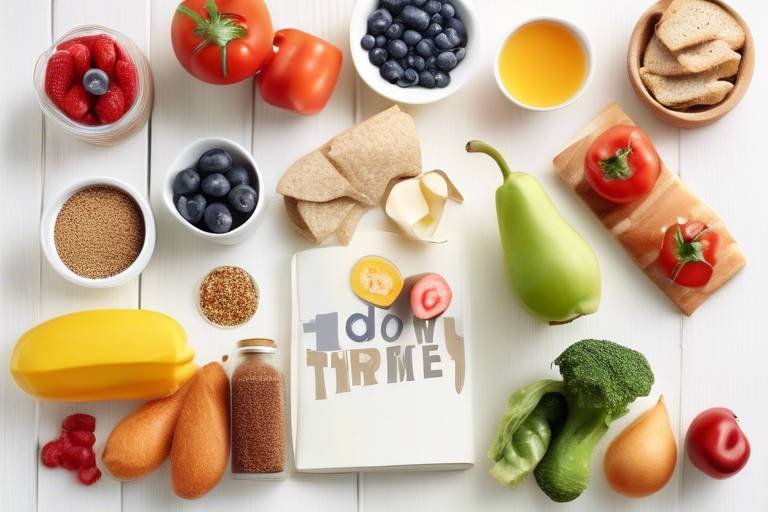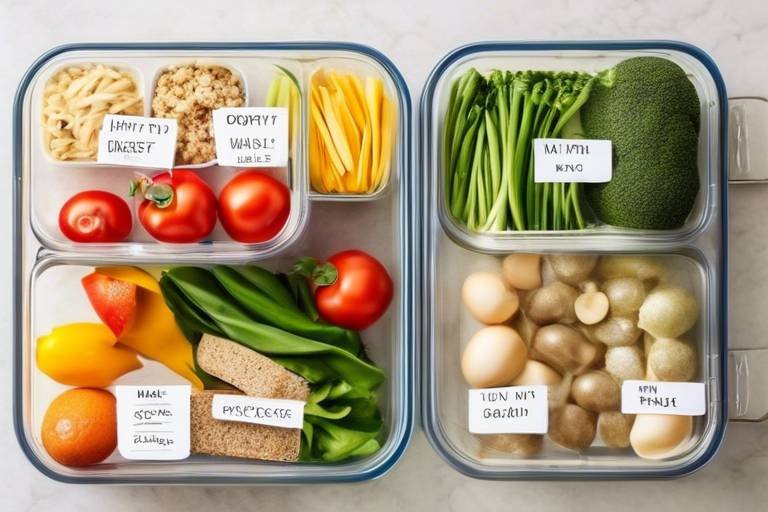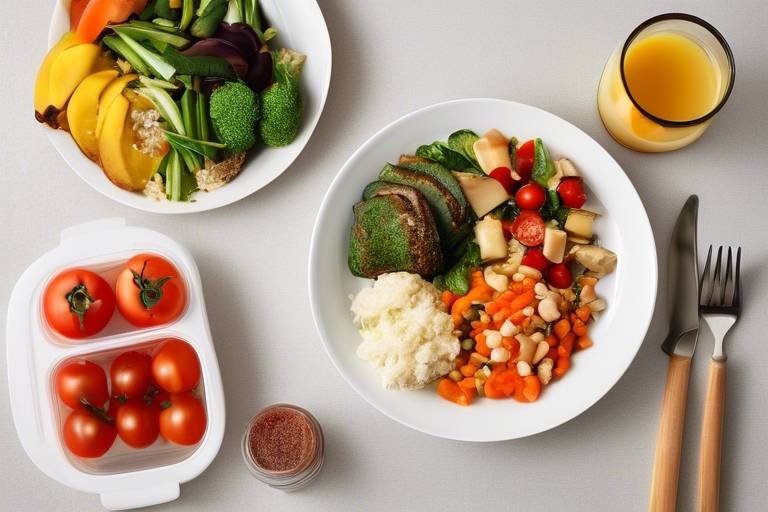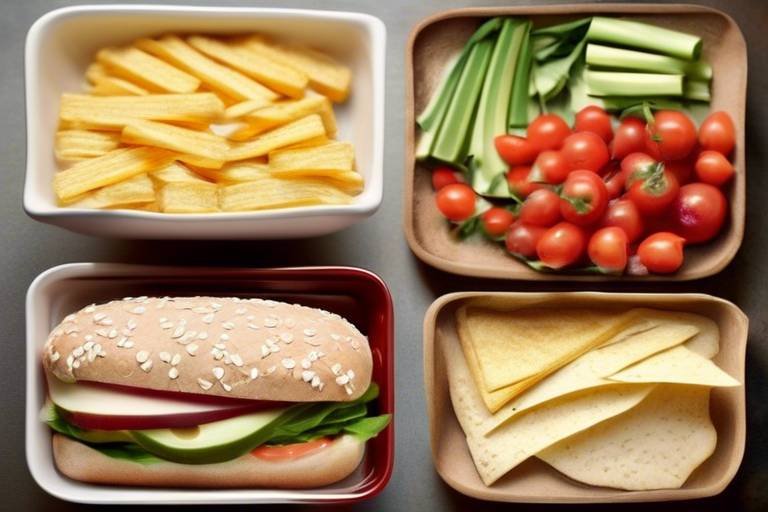How to Make Meal Planning a Family Affair
Have you ever wondered how to turn the mundane task of meal planning into a delightful family activity? Well, you're in the right place! This article explores how to involve the entire family in meal planning, making it an enjoyable and collaborative experience that fosters healthier eating habits and strengthens family bonds. Imagine the joy of sitting around the table, not just to eat, but to brainstorm and create delicious meals together. It’s like cooking up a recipe for quality time!
Involving everyone in meal planning comes with a treasure trove of benefits that go beyond just what’s on the dinner plate. For starters, it can significantly improve nutrition. When the whole family participates, they are more likely to choose wholesome ingredients and discover new healthy recipes. Additionally, family meal planning enhances communication and togetherness. It transforms mealtime into a cherished ritual rather than just a necessity. Think about it: when was the last time you enjoyed a meal without distractions? Family meal planning encourages everyone to sit down, share their thoughts, and connect over food.
Establishing a consistent meal planning schedule is crucial for making this process work smoothly. You want to create a routine that accommodates everyone’s availability and preferences. Perhaps you can sit down every Sunday evening to plan the week ahead. This way, everyone knows what to expect, and it allows each family member to contribute their ideas. You might even want to create a calendar or a meal planning chart that hangs in the kitchen, serving as a visual reminder of the exciting meals to come.
Engaging children in meal planning is not only fun but also educational. It’s a fantastic opportunity to teach them valuable cooking skills and healthy eating habits. You can start by asking them to choose a meal for the week. This could be anything from their favorite pasta dish to a new recipe they want to try. By giving them a say, you’re not just making them feel included; you’re also instilling a sense of responsibility and pride in their food choices.
Why not spice things up with some creative recipe selection activities? You could turn it into a game! For instance, each family member can pick a recipe from a different cuisine every week. You could even have a “mystery ingredient” challenge where everyone has to incorporate a specific food item into their meal. This not only encourages enthusiasm for trying new foods but also makes meal planning an adventure. Who knows? You might discover a new family favorite!
Once the meals are planned, it’s time for the fun part: grocery shopping! Involve the whole family in this outing. Make it a weekly adventure where everyone gets to help pick out fresh fruits and vegetables. This is a golden opportunity to teach kids about budgeting and making healthy food choices. You can even create a shopping list together, allowing them to check off items as you go. It’s a simple way to make them feel involved and responsible.
While it’s essential to respect individual tastes and preferences, guiding family members toward healthier meal options is equally important. You can introduce them to various fruits, vegetables, and whole grains in a fun way. For example, you could have a “Try Something New” night where everyone has to taste a food they’ve never had before. This not only promotes a balanced diet but also opens the door to exciting culinary experiences.
Like any family activity, meal planning can come with its fair share of challenges. Identifying common obstacles, such as time constraints or picky eaters, is the first step toward finding solutions. The key is to approach these challenges with a positive mindset. Remember, it’s about making the process smoother and more enjoyable for everyone involved.
Effective time management techniques can streamline meal planning and preparation. Consider batch cooking on weekends, where you prepare multiple meals at once. This not only saves time during the week but also ensures that you have healthy options readily available. You could also designate specific days for particular types of meals, like “Meatless Mondays” or “Taco Tuesdays.” These simple strategies can help fit meal planning seamlessly into your family's busy lifestyle.
Picky eaters can pose a challenge, but that doesn’t mean you have to compromise on nutrition. One strategy is to involve them in the cooking process. When children help prepare their meals, they may be more inclined to try new things. Additionally, you can create a “build-your-own” meal night, where everyone can customize their plates with different toppings or ingredients. This way, everyone gets to enjoy a meal that they love while still being part of the family meal planning experience.
- How can I involve my kids in meal planning? Start by letting them choose a meal each week or have fun recipe selection activities.
- What if my family has different dietary preferences? Respect individual tastes while introducing new, healthy options everyone can enjoy.
- How can I make grocery shopping more enjoyable? Turn it into a family outing where everyone participates in choosing ingredients.

Understanding the Benefits of Family Meal Planning
When it comes to meal planning, many people think of it as a chore, but involving the entire family transforms it into a fun and collaborative adventure! Not only does this approach promote healthier eating habits, but it also strengthens family bonds. Picture this: instead of everyone grabbing a quick bite alone, you gather around the dining table, sharing ideas and recipes, laughing, and learning together. How can you pass up that opportunity?
First and foremost, let's talk about nutrition. By planning meals together, families can ensure they are including a variety of food groups, which is essential for a balanced diet. When everyone participates, there’s a greater chance of incorporating fruits, vegetables, whole grains, and proteins into the menu. This not only improves the quality of meals but also teaches children about the importance of nutrition from an early age. After all, when kids help choose their meals, they are more likely to eat what’s on their plates!
Moreover, family meal planning enhances communication. It creates a space where everyone can express their preferences and dislikes, fostering an environment of respect and understanding. Kids learn to articulate their thoughts about food, while parents can share insights about nutrition and cooking. This open dialogue can lead to deeper conversations about health, culture, and even family traditions. Isn’t it amazing how something as simple as meal planning can spark meaningful discussions?
Another significant benefit is the opportunity for togetherness. Meal planning encourages families to spend quality time together, which can be rare in our fast-paced lives. When everyone is involved, it becomes a shared responsibility, making each family member feel valued. You might even discover hidden talents in the kitchen or find a new favorite recipe that becomes a family tradition! Plus, cooking together can be a delightful experience filled with laughter and creativity.
To sum it up, the benefits of family meal planning are numerous:
- Improved nutrition: Ensures a balanced diet with diverse food choices.
- Enhanced communication: Fosters open dialogue about food preferences and health.
- Strengthened family bonds: Creates opportunities for quality time and shared responsibilities.
By making meal planning a family affair, you are not just preparing food; you are cultivating a healthier lifestyle and nurturing relationships. So, why not gather everyone around the table this week and start planning your meals together? You might be surprised by how much fun it can be!

Creating a Family Meal Planning Schedule
Establishing a family meal planning schedule is like setting the stage for a delightful family performance. It requires coordination, creativity, and a sprinkle of enthusiasm. The first step is to gather everyone around the table—yes, that table that’s often cluttered with homework, gadgets, and maybe a few crumbs from last night’s dinner. This is where the magic happens! By discussing everyone’s availability and preferences, you can create a schedule that accommodates all family members. Think of it as a family calendar, but instead of appointments, it’s filled with delicious meals!
To kick off your meal planning journey, consider setting aside a specific day each week for this activity. Many families find Sundays work well, as it allows them to prepare for the week ahead. You might want to create a visual meal plan that everyone can see. A simple whiteboard or a colorful chart on the fridge can serve as a constant reminder of what’s cooking. This not only keeps everyone informed but also builds excitement about the upcoming meals.
When creating the schedule, it's essential to include everyone’s input. After all, meal planning is a team effort! You can use a fun method to gather ideas, such as a family brainstorming session where everyone suggests their favorite meals. Write these suggestions down, and then you can categorize them based on who wants to eat what on which day. This approach ensures that everyone feels included and valued, making them more likely to enjoy the meals prepared.
Here’s a simple format you can follow to create a family meal planning schedule:
| Day | Meal | Cook |
|---|---|---|
| Monday | Spaghetti and Meatballs | Dad |
| Tuesday | Taco Night | Mom |
| Wednesday | Grilled Chicken Salad | Teen |
| Thursday | Homemade Pizza | Kids |
| Friday | Fish Tacos | Mom |
As you can see, this schedule not only outlines what meals will be prepared each day but also assigns cooking responsibilities. This way, everyone contributes, and it becomes a fun family affair rather than a chore. You can even rotate the cooking responsibilities weekly, giving everyone a chance to shine in the kitchen.
Another great tip is to incorporate a “leftovers night” into your schedule, which can save time and reduce food waste. This is a night where you can creatively use any extra ingredients from the week. Think of it as a culinary scavenger hunt, where you mix and match to create something new and delicious!
Finally, don’t forget to keep the schedule flexible. Life happens, and sometimes plans change. If someone has a last-minute commitment, it’s okay to swap meals around. The key is to maintain open communication and keep the spirit of family meal planning alive. Remember, it’s not just about the food; it’s about the time spent together, the laughter shared, and the bonds strengthened over a delicious meal.

Involving Kids in the Process
When it comes to meal planning, involving kids can transform the entire experience into a fun and engaging activity. Not only does it give them a sense of ownership over their meals, but it also opens the door to teaching them essential life skills. Imagine the joy on their faces when they see a dish they helped create on the dinner table! By including them in the process, you're not just making dinner; you're crafting memories that will last a lifetime.
One of the best ways to get kids excited about meal planning is to turn it into a game. You can set up a "recipe challenge," where each family member selects a recipe that they want to try. This can be as simple as flipping through a cookbook or browsing online for ideas. Kids love to feel like they have a say in what’s for dinner, and by giving them the freedom to choose, you're encouraging them to explore new flavors and ingredients. Plus, it sparks their creativity! You might be surprised by the unique combinations they come up with.
Additionally, consider setting up a weekly theme night. For example, you could have "Taco Tuesdays" or "Pasta Fridays." This not only simplifies the planning process but also gives kids something to look forward to each week. They can help decide what toppings to include or what type of pasta to make, which fosters a sense of teamwork. You might even want to create a colorful calendar in the kitchen where everyone can see the meal plan. This visual aid can excite kids about what’s coming up and keep them engaged.
Another fantastic way to involve children is by teaching them basic cooking skills. Start with simple tasks that match their age and abilities. For instance, younger kids can wash vegetables, while older ones can chop ingredients or mix batter. This hands-on experience not only builds confidence but also instills a sense of accomplishment. As they learn to cook, they gain an appreciation for the effort that goes into making a meal, which can lead to healthier eating habits.
Incorporating a bit of education into the process can also be beneficial. Talk to your kids about the nutritional value of different foods and why certain ingredients are better choices than others. You might say, “Did you know that carrots are great for our eyesight?” This kind of dialogue can make meal planning an educational experience, allowing kids to understand the importance of nutrition while having fun.
Lastly, don’t forget to celebrate your culinary creations! After cooking together, sit down as a family and enjoy the meal you’ve prepared. Encourage everyone to share their thoughts about what they liked and what they might want to try next time. This not only reinforces positive communication but also strengthens family bonds. Involving kids in meal planning is more than just getting dinner on the table; it's about creating a nurturing environment where everyone feels valued and connected.

Fun Recipe Selection Activities
Getting the family involved in selecting recipes can transform meal planning from a mundane task into a delightful adventure. Imagine this: instead of simply deciding what's for dinner, you turn it into a game! One fun idea is to host a “Recipe Roulette” night. Each family member can write down their favorite recipe on a piece of paper, fold it up, and toss it into a bowl. Then, take turns drawing a recipe and discussing it. This not only makes the selection process exciting but also allows everyone to share their culinary preferences.
Another engaging activity is to create a “Theme Night” every week. For instance, you could have “Taco Tuesday” or “Pasta Friday.” Each week, a different family member can choose the theme and suggest a recipe that fits. This way, everyone gets a chance to shine, and it adds an element of anticipation to the week. You can even make it more interactive by having a family vote on which theme to choose for the following week.
For the little ones, consider incorporating a “Cooking Challenge”. Set a timer and challenge them to come up with a recipe using a specific set of ingredients you already have at home. This not only sparks creativity but also encourages resourcefulness in the kitchen. After the challenge, have a family taste test to decide whose recipe reigns supreme! This method not only engages their imagination but also teaches them about balancing flavors and textures.
Lastly, don’t forget the power of visuals! Create a “Recipe Vision Board” where everyone can pin images of dishes they want to try. You can use a corkboard or a digital platform like Pinterest. This visual representation can inspire everyone and make them excited about meal planning. Plus, it’s a great way to explore different cuisines and cultures, broadening everyone’s culinary horizons.
Incorporating these fun recipe selection activities not only makes meal planning enjoyable but also fosters a sense of teamwork and creativity within the family. By engaging everyone in the process, you’re setting the stage for healthier eating habits and creating lasting memories in the kitchen.
- How can I get my kids excited about meal planning?
Involve them in the process by letting them choose recipes, participate in grocery shopping, or even assist in cooking. Making it a fun and interactive experience will spark their interest.
- What if my family has different dietary preferences?
Respect each person’s preferences by incorporating flexible meal options. For instance, you can prepare a base meal and allow family members to customize their plates with different toppings or sides.
- How can we overcome time constraints when meal planning?
Consider meal prepping on weekends, creating quick recipes, or utilizing slow cookers to save time during busy weekdays. Planning ahead can make a big difference!

Grocery Shopping Together
Grocery shopping can often feel like a chore, but when you turn it into a family affair, it transforms into an exciting adventure! Imagine bustling through the aisles, laughter echoing as everyone contributes to the shopping list. Not only does this make the experience enjoyable, but it also serves as a fantastic opportunity to teach kids about budgeting, nutrition, and making healthy food choices. So, how can you make grocery shopping a fun family outing? Here are some ideas to get you started!
First, involve everyone in creating the shopping list. You can gather around the kitchen table and brainstorm what meals you’d like to prepare together for the week. This not only allows each family member to share their preferences but also encourages discussions about what’s healthy and what’s not. You could even create a colorful chart with categories like fruits, vegetables, proteins, and grains, allowing kids to color in their favorite foods as you go along. This visual aid makes it easier for them to understand the variety of food groups while actively participating in the planning process.
Next, turn the actual shopping into a scavenger hunt! Give each family member a specific section of the store to explore, or assign them a few items to find. This keeps everyone engaged and can lead to some fun surprises. For example, if your child is tasked with finding a new fruit, they might stumble upon something like dragon fruit or star fruit, sparking curiosity and excitement about trying new foods. Plus, it helps them learn to navigate the grocery store, a skill they'll use throughout their lives.
While shopping, take the time to educate your family about making healthier choices. As you stroll through the aisles, discuss why certain foods are better options than others. For instance, you can explain the benefits of whole grains over processed ones or the importance of choosing fresh produce. This not only promotes healthy eating habits but also encourages critical thinking about food choices. Remember, the goal is to make it informative yet enjoyable, so keep the atmosphere light and fun!
Lastly, don’t forget to celebrate your grocery haul! Once you’ve returned home with your bounty of fresh ingredients, gather in the kitchen and unpack everything together. You could even set up a mini “taste test” with some of the new items you bought. This not only reinforces the idea of trying new foods but also strengthens family bonds as you share in the experience of cooking and tasting together. By making grocery shopping a collaborative effort, you’re not just filling your pantry; you’re creating lasting memories and instilling valuable life skills in your children.
In conclusion, grocery shopping together as a family is more than just a means to stock up on food; it’s an opportunity to bond, learn, and have fun. So next time you head to the store, don’t go alone! Invite your family along for the ride, and watch as the mundane transforms into a delightful adventure filled with laughter, learning, and love.
- How can I make grocery shopping more engaging for my kids? Try turning it into a scavenger hunt or involving them in creating the shopping list!
- What are some tips for teaching kids about healthy eating while shopping? Discuss the nutritional benefits of different foods as you shop and encourage them to ask questions.
- Can grocery shopping help with family bonding? Absolutely! Shopping together creates shared experiences that strengthen family ties.

Encouraging Healthy Choices
When it comes to meal planning, one of the most important aspects is encouraging healthy choices among family members. It’s not just about what’s on the plate; it’s about fostering a mindset that prioritizes nutrition and wellness. You might be wondering, how can we make healthy eating a family affair? Well, it all starts with open communication and understanding each other’s preferences. Consider this: if every family member feels heard and valued in the decision-making process, they’re more likely to embrace the meals you prepare together.
One effective strategy is to create a balanced meal plan that respects individual tastes while promoting variety. This means incorporating a range of food groups—fruits, vegetables, whole grains, and lean proteins—while also allowing for personal choices. For instance, you might plan a taco night where everyone can customize their meal with different toppings. This not only makes the meal more enjoyable but also gives everyone a sense of ownership over their food choices.
Moreover, you can introduce a fun element by having a weekly “healthy challenge.” This could involve each family member selecting a nutritious recipe they’d like to try or incorporating a new fruit or vegetable into the meals. You might even consider setting up a friendly competition where everyone rates the dishes based on taste, creativity, and healthiness. This not only encourages healthy eating but also sparks excitement around meal times.
Another crucial aspect is to lead by example. If parents prioritize healthy eating, children are likely to follow suit. Make it a point to discuss the benefits of various foods and how they contribute to overall health. For instance, explain how carrots are great for eyesight or how whole grains provide lasting energy. This educational approach can transform mealtime into a learning experience, creating a deeper appreciation for wholesome foods.
Additionally, it’s important to be mindful of the environment in which meals are enjoyed. Create a positive dining atmosphere by minimizing distractions—like screens—and encouraging conversations about the day. This not only strengthens family bonds but also allows everyone to focus on the food and its nutritional value. You might even consider using a family meal calendar to plan meals and highlight healthy choices, making it easier to stay on track.
In summary, encouraging healthy choices within the family is about more than just the food itself. It’s about creating a culture of health and wellness that everyone can participate in. By involving each family member in the planning process, leading by example, and fostering an enjoyable mealtime atmosphere, you can cultivate a lifestyle that prioritizes nutritious eating habits. Remember, the goal is to make healthy eating a natural part of your family’s routine, not a chore!
- How can I get my picky eater to try new foods?
Start by introducing new foods alongside their favorites. Encourage them to take small bites and praise their efforts to try something new. - What are some easy healthy snacks for kids?
Consider options like sliced fruits, yogurt with granola, or veggie sticks with hummus. These are not only nutritious but also fun to eat! - How can we make grocery shopping fun?
Turn it into a game! Create a scavenger hunt list of items to find or let each family member pick one item for the week.

Overcoming Meal Planning Challenges
Meal planning can sometimes feel like navigating a maze, with twists and turns that can leave you feeling frustrated and overwhelmed. But fear not! By identifying common obstacles and implementing practical solutions, you can transform meal planning from a daunting task into an enjoyable family affair. One of the biggest challenges families face is time management. With everyone’s schedules packed tighter than a can of sardines, finding the time to plan, shop, and cook can seem impossible. However, setting aside just a little time each week for meal planning can save you countless hours in the kitchen later. Imagine dedicating just 30 minutes every Sunday to outline meals for the week ahead. You’ll be amazed at how much smoother your week will flow!
Another common hurdle is dealing with picky eaters. Kids (and sometimes adults!) can be notoriously choosy about what goes on their plates. This can make it tough to create a meal plan that satisfies everyone’s taste buds. The key here is to involve everyone in the planning process. Ask your picky eaters to suggest one or two meals they enjoy, and then work together to incorporate those into your weekly plan. This not only gives them a sense of ownership but also encourages them to be more adventurous with new foods. You might even consider creating a “theme night” where everyone gets to pick their favorite dish on a rotating basis, making mealtime something to look forward to!
Moreover, keeping a balanced diet while accommodating various tastes can feel like juggling flaming torches. To tackle this, consider the concept of “build-your-own” meals. For instance, taco night can be a hit, allowing everyone to choose their toppings, from lettuce and tomatoes to beans and cheese. This way, everyone can customize their meal according to their preferences while still enjoying the same base dish. It’s a win-win situation! Remember, the goal is to promote healthy eating without sacrificing enjoyment.
Lastly, let’s not forget about the importance of flexibility. Life can throw curveballs that disrupt even the best-laid plans. If you find yourself short on time one evening, it’s perfectly okay to pivot and opt for a quick and easy meal instead of what was originally planned. Having a few go-to recipes for busy nights can save the day. Think of meals that can be whipped up in under 30 minutes, like stir-fries or pasta dishes. Keeping a well-stocked pantry with essentials can also help you whip up something healthy in a pinch!
In summary, overcoming meal planning challenges is all about teamwork, creativity, and a sprinkle of flexibility. By working together as a family, you can turn meal planning into a fun and collaborative experience that not only improves your nutrition but also strengthens your family bonds. So, roll up your sleeves, gather the family, and get ready to tackle meal planning like the champions you are!
- How often should we plan our meals? It's ideal to plan meals weekly, but you can adjust based on your family's schedule and preferences.
- What if my kids don’t want to help? Start with small tasks and gradually involve them in more aspects of meal planning as they become comfortable.
- How can I ensure meals are healthy? Focus on incorporating a variety of fruits, vegetables, whole grains, and lean proteins into your meal plans.
- What if I run out of ideas for meals? Keep a list of favorite recipes and explore new ones together as a family to keep things fresh and exciting.

Time Management Tips
When it comes to meal planning, time management is key. After all, juggling busy schedules can feel like trying to keep a dozen plates spinning at once! To make meal planning a breeze, consider implementing some effective time management techniques that can streamline your efforts and fit seamlessly into your family's hectic lifestyle.
First off, set aside a specific day and time each week for meal planning. This dedicated time becomes a family ritual, allowing everyone to contribute ideas and share their preferences. Whether it’s Sunday afternoons or Wednesday evenings, having a regular schedule helps everyone know what to expect and prepares them for the week ahead. During this time, you can sit down together, look through recipes, and decide what meals everyone is excited about.
Another great tip is to prep meals in advance. This could mean chopping vegetables, marinating proteins, or even cooking entire meals that can be refrigerated or frozen. By dedicating some time on your meal planning day to prep, you save precious minutes during the week when everyone is running in different directions. Imagine coming home from a long day and having a delicious meal just waiting to be heated up!
Additionally, consider using a meal planning app or a shared calendar to keep track of meals, grocery lists, and even who’s responsible for cooking on which night. This not only keeps everyone in the loop but also allows for easy adjustments if plans change. Many apps allow you to create shopping lists based on your meal plan, making grocery shopping more efficient. You can even categorize items by aisle, which can save you time in the store!
Lastly, don't forget to involve your kids in the planning process. When children are engaged, they are more likely to eat what is prepared. You can set aside a few minutes each week for them to help choose meals. You might say, “Hey kids, let’s pick two new recipes to try this week!” This not only makes them feel included but also teaches them valuable skills in planning and preparing meals.
Incorporating these time management tips into your meal planning routine can transform what may seem like a daunting task into an enjoyable family affair. The goal is to make meal planning less of a chore and more of an opportunity to connect with each other, share ideas, and create delicious, healthy meals together.
- How can I make meal planning more fun for my family?
Try incorporating games or challenges when selecting recipes, or have themed dinner nights where everyone contributes to the theme! - What if my family has different dietary preferences?
Focus on creating meals that can be easily customized, such as tacos or stir-fries, where everyone can add their favorite ingredients. - How can I save money while meal planning?
Plan meals around sales and seasonal produce, and consider bulk buying items that you use frequently.

Dealing with Picky Eaters
Dealing with picky eaters can feel like navigating a culinary minefield. One moment you're excited to introduce a new dish, and the next, you're met with scrunched noses and a chorus of "I don't like that!" But fear not, because with a little creativity and understanding, you can turn mealtime into a more enjoyable experience for everyone, even the fussiest of eaters. The key is to approach the situation with patience and an open mind. After all, every child (and adult) has their own unique palate, and respecting that is crucial.
First things first, it’s essential to understand that being a picky eater often stems from a variety of factors, including texture, flavor, and even the presentation of food. So, instead of forcing a new food onto your little one, try to involve them in the process. You could ask them to help with meal prep or let them pick a new vegetable to try each week. This not only gives them a sense of control but also makes them more open to tasting what they’ve helped create. Imagine how proud they’ll feel serving a dish they had a hand in preparing!
Another effective strategy is to introduce new foods gradually. Instead of presenting an entire plate of unfamiliar items, consider pairing a new food with a familiar favorite. For instance, if your child loves pasta, try adding a small portion of roasted broccoli on the side. This way, they can explore new flavors without feeling overwhelmed. Over time, you can increase the amount of new foods on their plate while decreasing the familiar ones, easing them into a more diverse diet.
Here’s a simple table to illustrate some effective ways to introduce new foods to picky eaters:
| Method | Description |
|---|---|
| Involvement | Let kids help with meal prep and choose new ingredients. |
| Pairing | Combine new foods with familiar favorites for a gentle introduction. |
| Presentation | Make meals visually appealing to spark interest. |
| Taste Tests | Organize fun taste tests with different foods to make it exciting. |
Additionally, you can create a “Try It” chart where kids can earn stickers or points for trying new foods. This gamifies the experience and encourages them to step out of their comfort zone. Just remember to celebrate their efforts, no matter how small, because positive reinforcement can make a huge difference.
Lastly, keep in mind that persistence is key. It may take multiple introductions before your child decides they like a particular food, and that’s perfectly okay. The goal is to create a positive environment around meals where everyone feels comfortable trying new things. With time, patience, and a bit of creativity, you can turn picky eaters into adventurous foodies!
- What should I do if my child refuses to try new foods?
Encourage them gently without pressure. Try pairing new foods with their favorites and involve them in the cooking process.
- How can I ensure my child gets enough nutrients if they are picky?
Focus on variety within the foods they do enjoy and consider consulting with a nutritionist for tailored advice.
- Is it normal for kids to be picky eaters?
Yes! Many children go through phases of picky eating, and it’s a common part of their development.
Frequently Asked Questions
- Why is family meal planning important?
Family meal planning is crucial because it promotes healthier eating habits, encourages family bonding, and improves communication. When everyone participates, it fosters a sense of responsibility and accountability, making meals more enjoyable and nutritious.
- How can I get my kids involved in meal planning?
Engaging kids in meal planning can be fun! You can involve them by organizing recipe selection games, allowing them to pick out their favorite dishes, or even letting them help with grocery shopping. This not only makes them excited about meals but also teaches them valuable cooking skills.
- What are some tips for creating a meal planning schedule?
To create a successful meal planning schedule, consider everyone's availability and preferences. Set a specific day each week for planning, and use a calendar to keep track of meals. This consistency helps everyone know what to expect and allows for better preparation.
- How can I encourage healthy eating in my family?
Encouraging healthy eating can be achieved by introducing a variety of nutritious foods and respecting individual tastes. Involve family members in choosing meals that include fruits, vegetables, whole grains, and lean proteins. Make it a fun challenge to try new recipes together!
- What should I do if my family has picky eaters?
Dealing with picky eaters can be tough, but it’s important to be patient. Try to incorporate familiar foods into new recipes, and involve them in the cooking process. This can help them feel more comfortable with trying different meals while still enjoying their favorites.
- How can I manage my time effectively while meal planning?
Effective time management in meal planning can be achieved by setting aside specific times for planning and preparation. Batch cooking and prepping ingredients in advance can save time during the week. Additionally, creating a shopping list before heading to the store can streamline your grocery trips.



















